These archive pages are provided in order to make it easier for you to find items
that you remember seeing on the Airplanes and Rockets homepage. Of course probably
the easiest way to find anything on the website is to use the "Search AAR" box at
the top of every page.
1 |
2 |
3 |
4 |
5 |
6 |
7 |
8 |
9 |
10 |
11 |
12 |
13 |
14 |
15 |
16 |
17 |
18 |
19 |
20
21 |
22 |
23 |
24 |
25 |
26 |
27 |
28 |
29 |
30 |
31 |
32 |
33 |
34 |
35 |
36 | 37
| 38 | 39
 Anyone
who has been in aeromodeling for more than a decade or so is familiar with the name
William (Bill) Winter. Bill has been in the model airplane realm for longer than
a lot of us have been alive and is one of the true pioneers of the sport. He has
served as editor for a couple aircraft modeling magazines, and has written countless
articles both for the magazines he edited and for other special interest magazines.
When Popular Electronics came on the scene in the mid 1950s, Bill was editor
of Model Airplane News magazine. Radio control was beginning to mature
from its infant state when only hobbyists with an intimate knowledge of electronics
were able to participate. Oliver Read, editor of Popular Electronics, tapped
Bill's ample knowledge and skill to craft quite a few articles for his own magazine.
This one, "Radio
Control Installations," appeared in the February 1955 issue. As always when
reading this type of vintage material, it is amazing how much innovation has occurred
between then and today in the fields of electronics, materials, and construction
techniques... Anyone
who has been in aeromodeling for more than a decade or so is familiar with the name
William (Bill) Winter. Bill has been in the model airplane realm for longer than
a lot of us have been alive and is one of the true pioneers of the sport. He has
served as editor for a couple aircraft modeling magazines, and has written countless
articles both for the magazines he edited and for other special interest magazines.
When Popular Electronics came on the scene in the mid 1950s, Bill was editor
of Model Airplane News magazine. Radio control was beginning to mature
from its infant state when only hobbyists with an intimate knowledge of electronics
were able to participate. Oliver Read, editor of Popular Electronics, tapped
Bill's ample knowledge and skill to craft quite a few articles for his own magazine.
This one, "Radio
Control Installations," appeared in the February 1955 issue. As always when
reading this type of vintage material, it is amazing how much innovation has occurred
between then and today in the fields of electronics, materials, and construction
techniques...
 Anyone
who watched the
WKRP in Cincinnati sitcom back in the 1970s has to remember what was one of
the funniest episodes ever. Here is the 4 minutes that made Prime Time history.
In this Thanksgiving episode, station owner / manager Arthur Carlson decided he
would surprise the community with good deed - that doubled as a promotional stunt
for his radio station - by dropping turkeys from a helicopter for lucky shoppers
at the local shopping mall. Watch the disaster unfold as Les Nessman reports live,
and then see Carlson's final comment that is still used or alluded to in many comic
routines. Posting this video is an RF Cafe tradition. Have a Happy Thanksgiving! Anyone
who watched the
WKRP in Cincinnati sitcom back in the 1970s has to remember what was one of
the funniest episodes ever. Here is the 4 minutes that made Prime Time history.
In this Thanksgiving episode, station owner / manager Arthur Carlson decided he
would surprise the community with good deed - that doubled as a promotional stunt
for his radio station - by dropping turkeys from a helicopter for lucky shoppers
at the local shopping mall. Watch the disaster unfold as Les Nessman reports live,
and then see Carlson's final comment that is still used or alluded to in many comic
routines. Posting this video is an RF Cafe tradition. Have a Happy Thanksgiving!
 Back in the early to mid 1970s, I built a
Sterling Cirrus sailplane kit. Shortly thereafter
I bought my first radio control system (a used
3-channel OS Digitron),
and in a somewhat desperate attempt to fly an RC glider, actually managed to cram
two of its huge servos, a huge metal-cased receiver, and a NiCad airborne battery
pack (the only part that has not gotten smaller in the intervening 50 years) into
the cockpit area. Although the cockpit was very spacious, the balsa frame construction
was way too weak to support a radio system, but that didn't stop me... well, not
right away anyway. The ready-to-fly weight was probably three times the recommended
12 ounce nominal. Although the Cirrus has a generous 87-5/16" wingspan, with it
25:1 aspect ratio, the root chord is only a little over 4" and the wingtip chord
is around 1". Even with vertical sheer webbing between the upper and lower main
spars, the wing was far too weak for so much weight. After much work covering the
undercambered airfoil and compound curves around the fuselage with Japanese tissue
and brushing on a few coats of clear dope, it was finally ready to fly... Back in the early to mid 1970s, I built a
Sterling Cirrus sailplane kit. Shortly thereafter
I bought my first radio control system (a used
3-channel OS Digitron),
and in a somewhat desperate attempt to fly an RC glider, actually managed to cram
two of its huge servos, a huge metal-cased receiver, and a NiCad airborne battery
pack (the only part that has not gotten smaller in the intervening 50 years) into
the cockpit area. Although the cockpit was very spacious, the balsa frame construction
was way too weak to support a radio system, but that didn't stop me... well, not
right away anyway. The ready-to-fly weight was probably three times the recommended
12 ounce nominal. Although the Cirrus has a generous 87-5/16" wingspan, with it
25:1 aspect ratio, the root chord is only a little over 4" and the wingtip chord
is around 1". Even with vertical sheer webbing between the upper and lower main
spars, the wing was far too weak for so much weight. After much work covering the
undercambered airfoil and compound curves around the fuselage with Japanese tissue
and brushing on a few coats of clear dope, it was finally ready to fly...
 The cost of balsa, like everything else,
has been rising significantly since the COVID-19 "plandemic" hit the world a couple
years ago. Along with it the price of manufactured kits has gone up as well. A simple
1/16" x 3" sheet of balsa now costs around $2.00 (Sig price). In 2019, you could
get it for $1.13 per the stored page at Archive.org. That's a 77% increase. Being
a scratch builder of model airplanes, I frequently watch e-Bay, RC Universe,
RC Groups, etc., for bargains on balsa, but they're getting harder to come
by. If you have to order a balsa block online, there is a good chance it will end
up being more dense (i.e., harder and heavier) than desired. Since local hobby shops
(LHS's) are very rare these days, there is seldom an opportunity to go in and look
for a suitable block prior to purchasing... The cost of balsa, like everything else,
has been rising significantly since the COVID-19 "plandemic" hit the world a couple
years ago. Along with it the price of manufactured kits has gone up as well. A simple
1/16" x 3" sheet of balsa now costs around $2.00 (Sig price). In 2019, you could
get it for $1.13 per the stored page at Archive.org. That's a 77% increase. Being
a scratch builder of model airplanes, I frequently watch e-Bay, RC Universe,
RC Groups, etc., for bargains on balsa, but they're getting harder to come
by. If you have to order a balsa block online, there is a good chance it will end
up being more dense (i.e., harder and heavier) than desired. Since local hobby shops
(LHS's) are very rare these days, there is seldom an opportunity to go in and look
for a suitable block prior to purchasing...
 "How it grew from the Wright brothers’ airplane
to become the largest military branch of its kind in history. A B-17G Flying Fortress
and a B-52H Stratofortress fly in a heritage flight formation on Saturday, May 13,
2006 during the Defenders of Liberty Airshow at Barksdale Air Force Base, Louisiana.
These two aircraft represent 70 years of "fortresses." It was the first time in
50 years that they flew together in formation. Millions across the nation and around
the world celebrated the
75th anniversary of the United States Air Force on September 18, 2022. FLYING
also celebrates this 'birthday' and salutes the men and women who serve - and who
have served - as members of the U.S. Air Force and its predecessors. Origins: Orville
Wright made the world’s first controlled, powered, and sustained heavier-than-air
human flight on December 17, 1903. Less than four years later (August 1, 1907),
the U.S. Army Signal Corps formed an Aeronautical Division..." "How it grew from the Wright brothers’ airplane
to become the largest military branch of its kind in history. A B-17G Flying Fortress
and a B-52H Stratofortress fly in a heritage flight formation on Saturday, May 13,
2006 during the Defenders of Liberty Airshow at Barksdale Air Force Base, Louisiana.
These two aircraft represent 70 years of "fortresses." It was the first time in
50 years that they flew together in formation. Millions across the nation and around
the world celebrated the
75th anniversary of the United States Air Force on September 18, 2022. FLYING
also celebrates this 'birthday' and salutes the men and women who serve - and who
have served - as members of the U.S. Air Force and its predecessors. Origins: Orville
Wright made the world’s first controlled, powered, and sustained heavier-than-air
human flight on December 17, 1903. Less than four years later (August 1, 1907),
the U.S. Army Signal Corps formed an Aeronautical Division..."
 Declaring
any kind of straight LC tank circuit to be high stability is a bit of a stretch
when compared to the Q available simply by adding a crystal, even in 1958. Tone
modulation was an early method for achieving remote control of model airplanes,
boats, and cars. The number of channels with these
tone modulation systems is two times the number of modern proportional systems
in that moving the rudder left took one channel and moving it right took another.
Up and down elevator likewise took two channels. Therefore, this four channel system
is only two channels by today's terminology. Technology evolved into fully proportional
systems on crystal-controlled 27 MHz using pulse position modulation (PPM),
then to 72 MHz, and today nearly every every R/C uses a combination of frequency-hopping
spread spectrum (FHSS) and direct-sequence spread spectrum (DSSS) in the 2.4 GHz
ISM band... Declaring
any kind of straight LC tank circuit to be high stability is a bit of a stretch
when compared to the Q available simply by adding a crystal, even in 1958. Tone
modulation was an early method for achieving remote control of model airplanes,
boats, and cars. The number of channels with these
tone modulation systems is two times the number of modern proportional systems
in that moving the rudder left took one channel and moving it right took another.
Up and down elevator likewise took two channels. Therefore, this four channel system
is only two channels by today's terminology. Technology evolved into fully proportional
systems on crystal-controlled 27 MHz using pulse position modulation (PPM),
then to 72 MHz, and today nearly every every R/C uses a combination of frequency-hopping
spread spectrum (FHSS) and direct-sequence spread spectrum (DSSS) in the 2.4 GHz
ISM band...
 Ambroid was probably the biggest name in
model aircraft cement. It has been around in one form or another since the early
1900s. The name is a portmanteau of amber (its color) and celluloid. By the time
I got into the balsa model building scene in the late 1960's, Duco cement was being
fairly widely used, and since it is what was on the shelf of my local convenience
store, that's what I used. A few years later when I was driving and could visit
hobby shops, I tried
Ambroid cement, but never really took to it, primarily because it seemed to
get brittle quickly. There was never a joint failure I could attribute to Duco cement,
so I stuck with it (pun intended). About ten years or so ago the price of Duco cement
began going way up, so nowadays I use mostly Sigment*. I had used Sigment occasionally
prior to that and had confidence in its integrity. It appears Ambroid cement is
no longer being manufactured, but Sigment is, so I highly recommend it as a general
purpose glue for balsa structures... Ambroid was probably the biggest name in
model aircraft cement. It has been around in one form or another since the early
1900s. The name is a portmanteau of amber (its color) and celluloid. By the time
I got into the balsa model building scene in the late 1960's, Duco cement was being
fairly widely used, and since it is what was on the shelf of my local convenience
store, that's what I used. A few years later when I was driving and could visit
hobby shops, I tried
Ambroid cement, but never really took to it, primarily because it seemed to
get brittle quickly. There was never a joint failure I could attribute to Duco cement,
so I stuck with it (pun intended). About ten years or so ago the price of Duco cement
began going way up, so nowadays I use mostly Sigment*. I had used Sigment occasionally
prior to that and had confidence in its integrity. It appears Ambroid cement is
no longer being manufactured, but Sigment is, so I highly recommend it as a general
purpose glue for balsa structures...
 All the world's
astronauts have been launched to the ISS via the communist, America-hating countries
of Russia and China since the Space Shuttle program shut down in
2011, with no
standby replacement capability. "NASA's moon rocket
is back on the pad for another launch attempt, following more repairs. The 322-foot
rocket departed its hangar in the middle of the night and completed the 4-mile trip
shortly after sunrise Friday. NASA is aiming for a launch attempt on Nov. 14, sending
an empty crew capsule around the moon and back in a dramatic flight test before
astronauts climb aboard in a couple years. Forecasters are keeping their eyes on
potential tropical weather that could interfere. It is NASA's biggest step yet to
get astronauts back on the moon by 2025. The space agency is nearing the 50th anniversary
of its last human moon landing: Apollo 17 in December 1972..." All the world's
astronauts have been launched to the ISS via the communist, America-hating countries
of Russia and China since the Space Shuttle program shut down in
2011, with no
standby replacement capability. "NASA's moon rocket
is back on the pad for another launch attempt, following more repairs. The 322-foot
rocket departed its hangar in the middle of the night and completed the 4-mile trip
shortly after sunrise Friday. NASA is aiming for a launch attempt on Nov. 14, sending
an empty crew capsule around the moon and back in a dramatic flight test before
astronauts climb aboard in a couple years. Forecasters are keeping their eyes on
potential tropical weather that could interfere. It is NASA's biggest step yet to
get astronauts back on the moon by 2025. The space agency is nearing the 50th anniversary
of its last human moon landing: Apollo 17 in December 1972..."
 My Ace
All Star biplane was built while I was stationed at Robins Air Force Base, in
Warner Robins, Georgia (just south of Macon). A pair of foam wings help it to build
quickly. Ace sold both this tapered chord version and a constant chord version of
the foam wings for decades, and they are still very popular on eBay when they come
up for sale. I put an OS .15 engine up front, and three channels worth of Hobby
Shack Cirrus 4-channel radio in it. My memory of the All Star is not very clear,
although I do remember flying it in a field somewhere out on the back 40 (more like
back 400) acres of the base where no full-size air traffic ventured. It lost its
life during some dumb low-level maneuver, and went down really far away. That involved
walking through a lot of tall grass - in Georgia, where snakes and even alligators
were not uncommon. I seriously considered just leaving it there, but my unwillingness
to abandon that amount of investment (quite a lot for a USAF enlisted guy's pay)
overpowered the chicken-ness in me and I cautiously waded over to it. I snatched
it up and made like an F-15 back to open ground exactly in the path from which I
came... My Ace
All Star biplane was built while I was stationed at Robins Air Force Base, in
Warner Robins, Georgia (just south of Macon). A pair of foam wings help it to build
quickly. Ace sold both this tapered chord version and a constant chord version of
the foam wings for decades, and they are still very popular on eBay when they come
up for sale. I put an OS .15 engine up front, and three channels worth of Hobby
Shack Cirrus 4-channel radio in it. My memory of the All Star is not very clear,
although I do remember flying it in a field somewhere out on the back 40 (more like
back 400) acres of the base where no full-size air traffic ventured. It lost its
life during some dumb low-level maneuver, and went down really far away. That involved
walking through a lot of tall grass - in Georgia, where snakes and even alligators
were not uncommon. I seriously considered just leaving it there, but my unwillingness
to abandon that amount of investment (quite a lot for a USAF enlisted guy's pay)
overpowered the chicken-ness in me and I cautiously waded over to it. I snatched
it up and made like an F-15 back to open ground exactly in the path from which I
came...
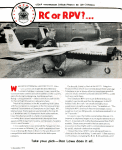
I remember receiving my copy of the September 1973 issue of
American Aircraft Modeler
magazine with the photo of the
Sparrow RPV (remotely piloted vehicle) on the cover. Such a thing was a big
deal back in the day. It was ground-breaking research and development for small
RPVs with real-time video feedback. There was no Global Positioning System (GPS)
to help guide the airplane and flight stabilization was relatively crude. Well-known
R/C modeler and former AMA president
Don
Lowe was on the team. "On Monday, Oct 19th Jim Dalton and Doug Erhardt delivered
a new aircraft to the museum, the Sparrow. Offered by Jim and accepted by the Museum's
Acquisition committee, the aircraft was designed by Raymond Fredette of the Flight
Dynamics Laboratory at Wright-Patterson Air Force Base in the early 1970s..."
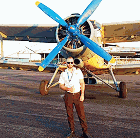 If you thought
the only 1940's-60's era vehicles still serving as mainstream transportation in
Cuba were rusting hulks of Chevys and Fords, check out this Antonov An−2 biplane
just used by pilot Ruben Martinez to escape the island paradise. This plane could
have been on an airport tarmac during the
Cuban Missile Crisis.
That beautiful radial engine is similar to the ones in the Boeing B−17 Superfortress
used in WWII. Maybe Mr. Martinez should have routed his flight to cross into
the USA via Mexico, because recently some
Cuban refugees arriving via the ocean have been returned, while millions of
undocumented, unauthorized aliens are welcomed at the land border. The State Department
began allowing
travel to Cuba for certain purposes in 2017 in spite of the long-standing atrocious
human rights policies. Here is a video of an R/C
Antonov An−2... If you thought
the only 1940's-60's era vehicles still serving as mainstream transportation in
Cuba were rusting hulks of Chevys and Fords, check out this Antonov An−2 biplane
just used by pilot Ruben Martinez to escape the island paradise. This plane could
have been on an airport tarmac during the
Cuban Missile Crisis.
That beautiful radial engine is similar to the ones in the Boeing B−17 Superfortress
used in WWII. Maybe Mr. Martinez should have routed his flight to cross into
the USA via Mexico, because recently some
Cuban refugees arriving via the ocean have been returned, while millions of
undocumented, unauthorized aliens are welcomed at the land border. The State Department
began allowing
travel to Cuba for certain purposes in 2017 in spite of the long-standing atrocious
human rights policies. Here is a video of an R/C
Antonov An−2...
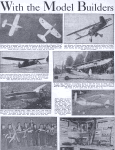 To the average Joe model builder who otherwise
has no shot at national recognition, having his model airplane featured in a magazine
like this 1939 issue of Flying Aces was a major source of pride. Even today
with easy access to making yourself known on the Internet, there is still something
special about seeing your self and/or your model appear in print. The Academy of
Model Aeronautics (AMAs) has each month a "Focal Point" section in its Model
Aviation magazine consisting of a collection of photos and descriptions of
models submitted by members. Most seem to be radio control, with an occasional control
line or free flight model. I even managed to have my scratch built 105% Aquila sailplane
in there a few years ago. As you can see in this "With
the Model Builders" page that there were no R/C models at all. The Good brothers
(Walt and Bill) were still in the early stages of developing reliable radio systems
at the time... To the average Joe model builder who otherwise
has no shot at national recognition, having his model airplane featured in a magazine
like this 1939 issue of Flying Aces was a major source of pride. Even today
with easy access to making yourself known on the Internet, there is still something
special about seeing your self and/or your model appear in print. The Academy of
Model Aeronautics (AMAs) has each month a "Focal Point" section in its Model
Aviation magazine consisting of a collection of photos and descriptions of
models submitted by members. Most seem to be radio control, with an occasional control
line or free flight model. I even managed to have my scratch built 105% Aquila sailplane
in there a few years ago. As you can see in this "With
the Model Builders" page that there were no R/C models at all. The Good brothers
(Walt and Bill) were still in the early stages of developing reliable radio systems
at the time...
 This
Sketchbook was
scanned from the March 1957 issue of American Modeler magazine, published
by the Academy of Model Aeronautics. Most building tips are timeless. Even in this
era of ready-to-fly (RTF), almost-ready-to-fly (ARF), bind-and-fly (BAF), etc.,
there are still many modelers who build their own aircraft. Nearly all top tier
competition fliers build their own models, as do aficionados of vintage (aka old-timer)
models. Some guys just would rather build than buy a pre-build airplane, whether
from a kit or from plans. I like the idea of using a sharpened bullet cartridge
for boring lightening holes in ribs, tail surfaces, etc., rather than using a drill
bit. The tip about using a slot in the bellcrank for the flaps of a control line
stunt models seems a bit iffy, since it can permit oscillations (fluttering) during
normal flight... This
Sketchbook was
scanned from the March 1957 issue of American Modeler magazine, published
by the Academy of Model Aeronautics. Most building tips are timeless. Even in this
era of ready-to-fly (RTF), almost-ready-to-fly (ARF), bind-and-fly (BAF), etc.,
there are still many modelers who build their own aircraft. Nearly all top tier
competition fliers build their own models, as do aficionados of vintage (aka old-timer)
models. Some guys just would rather build than buy a pre-build airplane, whether
from a kit or from plans. I like the idea of using a sharpened bullet cartridge
for boring lightening holes in ribs, tail surfaces, etc., rather than using a drill
bit. The tip about using a slot in the bellcrank for the flaps of a control line
stunt models seems a bit iffy, since it can permit oscillations (fluttering) during
normal flight...
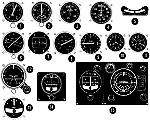 Sure, you can go online and find hundreds
or maybe thousands of instances of real-life
aircraft instrument images for your model airplane or helicopter, then scale
them to the right size and do a high definition color printout for gluing onto the
panel of your latest pride and joy. However, prior to just a couple decades ago,
the task was more difficult. You could fairly easily find instrument images in magazines
and books and then make copies on a printer or copying machine; some even had a
scaling function allowing you to change the size to fit your need. That was so for
about the last four to five decades, and often gaining access to a printer. Before
that, it was necessary to either be lucky enough to find printed images of the correct
size, or buy a set of printed instruments from a company that sold instruments sets
of various scales... Sure, you can go online and find hundreds
or maybe thousands of instances of real-life
aircraft instrument images for your model airplane or helicopter, then scale
them to the right size and do a high definition color printout for gluing onto the
panel of your latest pride and joy. However, prior to just a couple decades ago,
the task was more difficult. You could fairly easily find instrument images in magazines
and books and then make copies on a printer or copying machine; some even had a
scaling function allowing you to change the size to fit your need. That was so for
about the last four to five decades, and often gaining access to a printer. Before
that, it was necessary to either be lucky enough to find printed images of the correct
size, or buy a set of printed instruments from a company that sold instruments sets
of various scales...
 Airplanes and Rockets website visitor
Lieven M. requested that this article on the Blohm Voss 141-B (BV 141-B)
be scanned and posted from the August 1970 edition of American Aircraft Modeler
magazine. The BV 141-B, designed by Mr. Terry Aldrich, is a unique scale subject
in that it is a World War II German fighter-bomber featuring an asymmetrical
configuration. It looks sort of like a P-38 Lightning with the right boom missing.
The engine in on the left at the nose end of the single fuselage boom, and the pilot
compartment is on the right, on the wing. The horizontal stabilizer span is about
80% to the left of the vertical fin, and 20% to the right of it. Construction uses
sheet balsa for the wings, tail surfaces, and profile fuselage. Power is provided
by a single 049 engine... Airplanes and Rockets website visitor
Lieven M. requested that this article on the Blohm Voss 141-B (BV 141-B)
be scanned and posted from the August 1970 edition of American Aircraft Modeler
magazine. The BV 141-B, designed by Mr. Terry Aldrich, is a unique scale subject
in that it is a World War II German fighter-bomber featuring an asymmetrical
configuration. It looks sort of like a P-38 Lightning with the right boom missing.
The engine in on the left at the nose end of the single fuselage boom, and the pilot
compartment is on the right, on the wing. The horizontal stabilizer span is about
80% to the left of the vertical fin, and 20% to the right of it. Construction uses
sheet balsa for the wings, tail surfaces, and profile fuselage. Power is provided
by a single 049 engine...
 "The
eVTOL movement came on the scene around 2012, promising fast, point-to-point,
intra-urban transportation -after an Uber-in-the-sky vision. Their futuristic looks
and eco-friendly, mainly lithium battery-powered electrical propulsion systems garnered
plenty of publicity and enthusiasm. A blizzard of designs ensued. Transport Up,
a website that tracks news related to electric vertical takeoff and landing aircraft,
says there are some 98 designs now in the works - not counting hoverbikes and other
single-person aircraft. The Vertical Flight Society's Electric VTOL News), also
covers the industry. It lists a whopping 679 designs, divided among vectored thrust,
lift and cruise, wingless multi-copters, electric rotorcraft, and hoverbike categories.
The National Business Aircraft Association reported that 400 companies are involved
in some segment of this future aviation vision, be it in UAM (urban air mobility),
AAM (advanced air mobility - including longer-range..." "The
eVTOL movement came on the scene around 2012, promising fast, point-to-point,
intra-urban transportation -after an Uber-in-the-sky vision. Their futuristic looks
and eco-friendly, mainly lithium battery-powered electrical propulsion systems garnered
plenty of publicity and enthusiasm. A blizzard of designs ensued. Transport Up,
a website that tracks news related to electric vertical takeoff and landing aircraft,
says there are some 98 designs now in the works - not counting hoverbikes and other
single-person aircraft. The Vertical Flight Society's Electric VTOL News), also
covers the industry. It lists a whopping 679 designs, divided among vectored thrust,
lift and cruise, wingless multi-copters, electric rotorcraft, and hoverbike categories.
The National Business Aircraft Association reported that 400 companies are involved
in some segment of this future aviation vision, be it in UAM (urban air mobility),
AAM (advanced air mobility - including longer-range..."
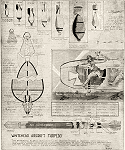 These are not your father's bombs; in fact,
they're your great-grandfather's bombs. Note that per the title "Bombs of
the World War," there was no "I" or "1" appended to it. That is because as we
learned in grammar class in elementary school while being instructed on creating
outlines, one does not assign a number "1" or a letter "a" or "A" if there will
be no number "2" or letter "b" or B." Since what we now refer to as World War I
was "the war to end all wars," there was no expectation that there would someday
be a World War II. Hence, up until the end of 1941, people referred to the
28 July, 1914 through 11 November, 1918 conflict simply as the "the World War" or
"the Great War." But I digress. Many of the bombs shown here were tossed out of
the cockpit by either the pilot or back seat bomber/gunner. BTW, when I saw that
the Whitehead Aircraft Torpedo supposedly had an 8,000 yard (24,000 feet, or 4.5
miles) range running on compressed air... These are not your father's bombs; in fact,
they're your great-grandfather's bombs. Note that per the title "Bombs of
the World War," there was no "I" or "1" appended to it. That is because as we
learned in grammar class in elementary school while being instructed on creating
outlines, one does not assign a number "1" or a letter "a" or "A" if there will
be no number "2" or letter "b" or B." Since what we now refer to as World War I
was "the war to end all wars," there was no expectation that there would someday
be a World War II. Hence, up until the end of 1941, people referred to the
28 July, 1914 through 11 November, 1918 conflict simply as the "the World War" or
"the Great War." But I digress. Many of the bombs shown here were tossed out of
the cockpit by either the pilot or back seat bomber/gunner. BTW, when I saw that
the Whitehead Aircraft Torpedo supposedly had an 8,000 yard (24,000 feet, or 4.5
miles) range running on compressed air...
 Airplanes and Rockets website visitor
Mel G. wrote to ask that I scan and post this article on Dick Mathis' famous
Bounty Hunter 1/2A free
flight airplane. It appeared in the September/October 1965 issue of American
Modeler magazine. Mel says he built one from a kit bought at MAL Hobby (Model Aircraft
Laboratories) back in the 1980s. According to their website MAL Hobby has been in
business in Irving, Texas, since 1948, but according to Archive.org their website
appears to have disappeared sometime about 2014. I could not find the Bounty Hunter
kit listed on their website. If you are looking for an article or plans not already
posted here, please send me an e-mail and I will be glad to do so if I happen to
have the issue you need... Airplanes and Rockets website visitor
Mel G. wrote to ask that I scan and post this article on Dick Mathis' famous
Bounty Hunter 1/2A free
flight airplane. It appeared in the September/October 1965 issue of American
Modeler magazine. Mel says he built one from a kit bought at MAL Hobby (Model Aircraft
Laboratories) back in the 1980s. According to their website MAL Hobby has been in
business in Irving, Texas, since 1948, but according to Archive.org their website
appears to have disappeared sometime about 2014. I could not find the Bounty Hunter
kit listed on their website. If you are looking for an article or plans not already
posted here, please send me an e-mail and I will be glad to do so if I happen to
have the issue you need...
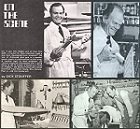 Whilst looking through some old issues of
American Aircraft Modeler magazine, I was quite surprised to find that
none other than radio great Paul
Harvey is (or was) a builder and flyer of radio controlled airplanes. The first
feature on Paul Harvey appeared in the May 1972 edition in a monthly column titled,
"On the Scene." (see below) Mr. Harvey then wrote a regular column titled "Paul
Harvey Views." Understandably, the column only ran for a few months - probably because
of his extremely busy schedule. I did a Google search to try to find information
on Paul Harvey's modeling activities, but could not find anything at all. That is
when I decided to go ahead and reprint this one article from the May 1974 edition
of American Aircraft Modeler. I hope he won't mind... Whilst looking through some old issues of
American Aircraft Modeler magazine, I was quite surprised to find that
none other than radio great Paul
Harvey is (or was) a builder and flyer of radio controlled airplanes. The first
feature on Paul Harvey appeared in the May 1972 edition in a monthly column titled,
"On the Scene." (see below) Mr. Harvey then wrote a regular column titled "Paul
Harvey Views." Understandably, the column only ran for a few months - probably because
of his extremely busy schedule. I did a Google search to try to find information
on Paul Harvey's modeling activities, but could not find anything at all. That is
when I decided to go ahead and reprint this one article from the May 1974 edition
of American Aircraft Modeler. I hope he won't mind...
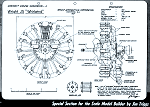 For a few months, Air Trails magazine
ran a series of scale line drawings called "Aircraft Engine Scrapbook" which were
meant to be cut out and put in a 3-ring binder. They were one-page information sheets
on various powerplants of the day containing dimensions, mechanical specifications
(displacement, horsepower, compression ration, rotations per minute, etc.), and
a brief note on the engine's production and usage history. This drawing for the
9−cylinder Wright
J5 "Whirlwind" radial engine must be the first of the series because it is numbered
as "−1." Interestingly, the Fokker company is included in the list of "American"
aircraft manufacturers who used the J5. I thought Fokker was primarily a Germany
/ Netherlands company, but according to the Wikipedia entry Anthony Fokker established
a presence in the United States in 1927, and eventually merged with General Motors
and then North American Aviation. It is ironic that the builder of the P-51 Mustang
and the B-25 Mitchell bomber... For a few months, Air Trails magazine
ran a series of scale line drawings called "Aircraft Engine Scrapbook" which were
meant to be cut out and put in a 3-ring binder. They were one-page information sheets
on various powerplants of the day containing dimensions, mechanical specifications
(displacement, horsepower, compression ration, rotations per minute, etc.), and
a brief note on the engine's production and usage history. This drawing for the
9−cylinder Wright
J5 "Whirlwind" radial engine must be the first of the series because it is numbered
as "−1." Interestingly, the Fokker company is included in the list of "American"
aircraft manufacturers who used the J5. I thought Fokker was primarily a Germany
/ Netherlands company, but according to the Wikipedia entry Anthony Fokker established
a presence in the United States in 1927, and eventually merged with General Motors
and then North American Aviation. It is ironic that the builder of the P-51 Mustang
and the B-25 Mitchell bomber...
 Sometimes when I change or replace the blade
on my bandsaw, I have to re-learn how to fold the blade into that nifty 3-ring configuration
it has in the package when new. Even with trying to carefully note how the new blade
unfolds, it can still difficult to get the old blade back in its original format.
It can be confounding and almost seems impossible to be able to fold the stiff blade
into that third loop without bending it. In fact the
bandsaw blade folds quite
easily when done properly. This time after figuring it out once again, I decided
to make a video of the process. There is probably a complicated equation in knot
theory which mathematically described the complex curve formed by the folded bandsaw
blade... Sometimes when I change or replace the blade
on my bandsaw, I have to re-learn how to fold the blade into that nifty 3-ring configuration
it has in the package when new. Even with trying to carefully note how the new blade
unfolds, it can still difficult to get the old blade back in its original format.
It can be confounding and almost seems impossible to be able to fold the stiff blade
into that third loop without bending it. In fact the
bandsaw blade folds quite
easily when done properly. This time after figuring it out once again, I decided
to make a video of the process. There is probably a complicated equation in knot
theory which mathematically described the complex curve formed by the folded bandsaw
blade...
 This
is kind of weird. It's either a phenomenal discovery or bad news for the Ingenuity
coaxial helicopter making the airborne rounds on Mars. The video clip shows the
'copter descending without anything hanging from its landing gear leg, and then
there is a wispy object dangling from it after taking off again. It looks like a
weak water flow from an aerated faucet - which obviously it cannot be - or maybe
a piece of Saran Wrap - which it also cannot be (... or could it be litter from
a Martian's sandwich?). NASA has designated it as
Foreign Object Debris (FOD). It'll be interesting to learn of NASA's conclusion. This
is kind of weird. It's either a phenomenal discovery or bad news for the Ingenuity
coaxial helicopter making the airborne rounds on Mars. The video clip shows the
'copter descending without anything hanging from its landing gear leg, and then
there is a wispy object dangling from it after taking off again. It looks like a
weak water flow from an aerated faucet - which obviously it cannot be - or maybe
a piece of Saran Wrap - which it also cannot be (... or could it be litter from
a Martian's sandwich?). NASA has designated it as
Foreign Object Debris (FOD). It'll be interesting to learn of NASA's conclusion.
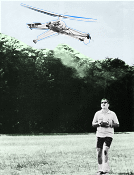 Imagine if your path to flying an R/C helicopter
involved first designing, then building, and then troubleshooting the contraption.
That was the burden of pioneers. We have people like
S.S.P. Helicopter designer
Gene Rock to thank for being able to enjoy the state-of-the-art models that are
available today. This article from the August 1972 edition of American Aircraft
Modeler magazine describes the process of machining all the metal parts for
an Enya .45-powered craft. Mr. Rock even designed a very successful mechanical gyro
for keeping the tail under control. If you have ever tried flying an R/C heli without
any type of gyro (I have, on a DuBro Tristar), you will fully appreciate what a
pleasure it is to not have to manually counter torque changes (throttle) with tail
rotor stick input from the transmitter. Around 2008 I bought a Blade MCX2 coaxial
rotor helicopter for flying inside, and the gyro is so good on that thing that you
can put it in a full speed pirouette... Imagine if your path to flying an R/C helicopter
involved first designing, then building, and then troubleshooting the contraption.
That was the burden of pioneers. We have people like
S.S.P. Helicopter designer
Gene Rock to thank for being able to enjoy the state-of-the-art models that are
available today. This article from the August 1972 edition of American Aircraft
Modeler magazine describes the process of machining all the metal parts for
an Enya .45-powered craft. Mr. Rock even designed a very successful mechanical gyro
for keeping the tail under control. If you have ever tried flying an R/C heli without
any type of gyro (I have, on a DuBro Tristar), you will fully appreciate what a
pleasure it is to not have to manually counter torque changes (throttle) with tail
rotor stick input from the transmitter. Around 2008 I bought a Blade MCX2 coaxial
rotor helicopter for flying inside, and the gyro is so good on that thing that you
can put it in a full speed pirouette...
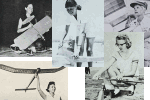 As I have written many times, the lack of
proportional representation of
women
and girls in the model airplane realm is not because when they do show up, no
attention is paid to them. In fact it is just the opposite. Go to any flying field
of any type - R/C, C/L, or F/F, and watch what happens when a girl shows up with
a model if you doubt it. In 1960 and in 2022, and all the years in between, the
fairer sex is sought out and highlighted by model aviation magazines. They are never
exploited, ignored, or criticized - just the opposite. You can be sure that any
female model builder/flyer and/or contest official receives due attention and credit.
The 1959 Academy of Model Aeronautics Nationals (Nats) is a prime example of that
which I claim to be so. Many other examples can be found in the articles posted
here on the AirplanesAndRockets.com website... As I have written many times, the lack of
proportional representation of
women
and girls in the model airplane realm is not because when they do show up, no
attention is paid to them. In fact it is just the opposite. Go to any flying field
of any type - R/C, C/L, or F/F, and watch what happens when a girl shows up with
a model if you doubt it. In 1960 and in 2022, and all the years in between, the
fairer sex is sought out and highlighted by model aviation magazines. They are never
exploited, ignored, or criticized - just the opposite. You can be sure that any
female model builder/flyer and/or contest official receives due attention and credit.
The 1959 Academy of Model Aeronautics Nationals (Nats) is a prime example of that
which I claim to be so. Many other examples can be found in the articles posted
here on the AirplanesAndRockets.com website...
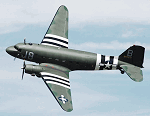 "We celebrate National Aviation Day with
a look at the world's first successful commercial passenger transport airplane.
The
Douglas Aircraft Company was a pioneer in early aviation and produced a number
of different aircraft. However, it is best known for its DC−3, among the most important
aircraft ever built. In Part 1 of this two-part series, the genesis of Douglas Aircraft
and the DC−1 and DC−2 were profiled. The DC−2 Started the Revolution As recounted
in Part 1, the DC−1 and DC−2 were developed after a request by Transcontinental
and Western Airlines (TWA). What was then United Airlines was TWA's rival in transcontinental
air service, using the Boeing 247. Because Boeing (then named United Aircraft and
Transport Corporation) also owned United, TWA sought an aircraft that would allow
it to compete. Douglas and his talented team designed and built the DC−1 in 1932-33..." "We celebrate National Aviation Day with
a look at the world's first successful commercial passenger transport airplane.
The
Douglas Aircraft Company was a pioneer in early aviation and produced a number
of different aircraft. However, it is best known for its DC−3, among the most important
aircraft ever built. In Part 1 of this two-part series, the genesis of Douglas Aircraft
and the DC−1 and DC−2 were profiled. The DC−2 Started the Revolution As recounted
in Part 1, the DC−1 and DC−2 were developed after a request by Transcontinental
and Western Airlines (TWA). What was then United Airlines was TWA's rival in transcontinental
air service, using the Boeing 247. Because Boeing (then named United Aircraft and
Transport Corporation) also owned United, TWA sought an aircraft that would allow
it to compete. Douglas and his talented team designed and built the DC−1 in 1932-33..."
 Air Trails HOBBIES for Young Men magazine,
which was published in the 1950s and 1960s, covered a wide array of subjects including
model cars, boats, trains, rockets, and helicopters. It may have billed itself as
targeting young men, but men of all ages enjoyed its monthly contents. The December
1945 edition had this spread on some early cars such as the
Pierce
Silver Arrow and 1922 Durant. The image of line drawings and brief descriptions
would also make a good wall poster if you want to print it out. If you are a vintage
car aficionado, then most likely you have visited the Jay Leno's Garage website.
He has one of the nicest private collections of antique automobiles and motorcycles
in the world... Air Trails HOBBIES for Young Men magazine,
which was published in the 1950s and 1960s, covered a wide array of subjects including
model cars, boats, trains, rockets, and helicopters. It may have billed itself as
targeting young men, but men of all ages enjoyed its monthly contents. The December
1945 edition had this spread on some early cars such as the
Pierce
Silver Arrow and 1922 Durant. The image of line drawings and brief descriptions
would also make a good wall poster if you want to print it out. If you are a vintage
car aficionado, then most likely you have visited the Jay Leno's Garage website.
He has one of the nicest private collections of antique automobiles and motorcycles
in the world...
 On May 10, 2012, Melanie and I visited the
Steven F. Udvar-Hazy
Center, part of the National Air and Space Museum, in Chantilly, Virginia. It
is the first time we have ever been there, although we have been to the main museum
in Washington, D.C., two or three times. The collection of airplanes, helicopters,
rockets, spacecraft, and associated engines and paraphernalia is utterly amazing.
Unfortunately, we only had two hours to take in the entire experience, so we rushed
around taking pictures and reading as many of the placards as possible in that time.
It is at the same time both heartening discouraging to see the names of wartime
manufacturing companies that no longer exist due to consolidation or the exporting
of work to other countries - even enemies like Red China... On May 10, 2012, Melanie and I visited the
Steven F. Udvar-Hazy
Center, part of the National Air and Space Museum, in Chantilly, Virginia. It
is the first time we have ever been there, although we have been to the main museum
in Washington, D.C., two or three times. The collection of airplanes, helicopters,
rockets, spacecraft, and associated engines and paraphernalia is utterly amazing.
Unfortunately, we only had two hours to take in the entire experience, so we rushed
around taking pictures and reading as many of the placards as possible in that time.
It is at the same time both heartening discouraging to see the names of wartime
manufacturing companies that no longer exist due to consolidation or the exporting
of work to other countries - even enemies like Red China...
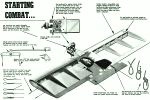 According to this 1960 Air Trails magazine
"Starting
Control Line Combat" article, the contest event first appeared in the AMA (Academy
of Model Aeronautics) rulebook in 1950. Hard to believe that was 72 years ago as
of this writing. It's equally hard to believe it was only 8 years before I was born
- ugh. Control line combat remains a very popular sport today, and is one of the
relatively few aspects of the hobby which has not changed considerably. Engines
have gotten more powerful and reliable, and building materials have improved, but
the basic outline of the airframe is about the same. The story reports on combat
rounds having up to five planes flying at once, duking it out for air superiority.
Too bad there's not a video of it with all the flyers trying desperately to not
become entangled in each other's lines or even keeping out of each other's way.
There must have been a lot of smashed balsa after that event. Anyway, this article
provides a lot of detail concerning all aspects of model construction, engine and
fuel tank setup, and flying. Interesting fact: In the early days of control line
combat, prolonged inverted flight was permitted... According to this 1960 Air Trails magazine
"Starting
Control Line Combat" article, the contest event first appeared in the AMA (Academy
of Model Aeronautics) rulebook in 1950. Hard to believe that was 72 years ago as
of this writing. It's equally hard to believe it was only 8 years before I was born
- ugh. Control line combat remains a very popular sport today, and is one of the
relatively few aspects of the hobby which has not changed considerably. Engines
have gotten more powerful and reliable, and building materials have improved, but
the basic outline of the airframe is about the same. The story reports on combat
rounds having up to five planes flying at once, duking it out for air superiority.
Too bad there's not a video of it with all the flyers trying desperately to not
become entangled in each other's lines or even keeping out of each other's way.
There must have been a lot of smashed balsa after that event. Anyway, this article
provides a lot of detail concerning all aspects of model construction, engine and
fuel tank setup, and flying. Interesting fact: In the early days of control line
combat, prolonged inverted flight was permitted...
 My Blade
230 S Smart R/C Helicopter had an unfortunate meeting with my foot. The result
of my stupidity is broken fuselage frame, blade holders, and a bent tail boom. That
appears to be the extent of the damage. I could buy the parts to restore and fly
it again, but I'm not that interested at this point. Prior to the Big Foot incident,
I had about 50 flights, all in the Stability mode, so it has not been subject to
strenuous conditions. Instead, I am offering all the components shown here for a
total of just $175 (+shipping). The BNF version of the Blade 230 S helicopter
(which this is, purchased from Horizon Hobby in March of 2022) currently costs $249.99
- although as of this writing they are on backorder. There are well over $300 worth
of parts here (including spares) that would make a good investment for excusing
your own mishaps... My Blade
230 S Smart R/C Helicopter had an unfortunate meeting with my foot. The result
of my stupidity is broken fuselage frame, blade holders, and a bent tail boom. That
appears to be the extent of the damage. I could buy the parts to restore and fly
it again, but I'm not that interested at this point. Prior to the Big Foot incident,
I had about 50 flights, all in the Stability mode, so it has not been subject to
strenuous conditions. Instead, I am offering all the components shown here for a
total of just $175 (+shipping). The BNF version of the Blade 230 S helicopter
(which this is, purchased from Horizon Hobby in March of 2022) currently costs $249.99
- although as of this writing they are on backorder. There are well over $300 worth
of parts here (including spares) that would make a good investment for excusing
your own mishaps...
 My
flight simulator software (MS Flight Sim 2002) and computer it runs on (HP i7 notebook)
are each more powerful than the software and computer that ran the
Douglas DC-8 pilot training simulator featured in this 1958 article in Popular
Electronics magazine. Two racks of 1000+ vacuum tubes did the figurative
electronic heavy lifting while massive DC motors did the literal physical cockpit
heavy lifting. The computer needed to handle as many as 40 variables at one time,
including 6 differential equations of motion. 100 servomotors, 540 amplifiers and
2,200 gears drove the instrument panel gauges, dials, and movie projector mechanisms.
The instrument panel description conjures images of the inside of a modern office-grade
copying machine with its very dense conglomeration of gears and axels... My
flight simulator software (MS Flight Sim 2002) and computer it runs on (HP i7 notebook)
are each more powerful than the software and computer that ran the
Douglas DC-8 pilot training simulator featured in this 1958 article in Popular
Electronics magazine. Two racks of 1000+ vacuum tubes did the figurative
electronic heavy lifting while massive DC motors did the literal physical cockpit
heavy lifting. The computer needed to handle as many as 40 variables at one time,
including 6 differential equations of motion. 100 servomotors, 540 amplifiers and
2,200 gears drove the instrument panel gauges, dials, and movie projector mechanisms.
The instrument panel description conjures images of the inside of a modern office-grade
copying machine with its very dense conglomeration of gears and axels...
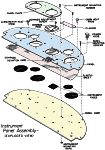 Modern day scale models are amazingly detailed
with functional miniature instruments, control yokes and joysticks moving in unison
with stabilizer, rudder, ailerons, throttle, and others. Access to relatively inexpensive
3-D printing, laser printers, and laser cutters has greatly enabled scale modelers.
The state of the art has advanced for far that competition is extremely stiff. Even
so, in the 1960's when this "Cockpit
Details for the Scale Model" article appeared in Air Trails magazine,
the skill level was quite impressive given the resources available at the time.
This particular subject is an instrument panel for a Piper J3 Cub, but photos from
scale contents of the era showed highly detailed cockpits for civilian and military
aircraft ranging from Cessna 180's to B-36 bombers and F−86 Saber jet fighters... Modern day scale models are amazingly detailed
with functional miniature instruments, control yokes and joysticks moving in unison
with stabilizer, rudder, ailerons, throttle, and others. Access to relatively inexpensive
3-D printing, laser printers, and laser cutters has greatly enabled scale modelers.
The state of the art has advanced for far that competition is extremely stiff. Even
so, in the 1960's when this "Cockpit
Details for the Scale Model" article appeared in Air Trails magazine,
the skill level was quite impressive given the resources available at the time.
This particular subject is an instrument panel for a Piper J3 Cub, but photos from
scale contents of the era showed highly detailed cockpits for civilian and military
aircraft ranging from Cessna 180's to B-36 bombers and F−86 Saber jet fighters...
 "Sustainable air travel has made big progress
over the last two years. Many airlines and carriers have exploited the opportunity
afforded by the drop in passenger numbers to scrap older, less economic and less
efficient planes. Planes spew out carbon dioxide (CO2) and nitrous oxides (NOx),
which also helps form ozone in the upper troposphere. They also emit particulates
and leave water-vapor trails (contrails), both of which trap heat. Sustainable air
travel has made big progress over the last two years. With airlines and plane manufacturers
keen to improve their environmental credentials, one simple solution is to power
aircraft with bio-fuel, known as
sustainable aviation fuel (SAF) in the trade. Existing aircraft can use jet
fuel mixed with 50% SAF without needing to be modified in any way. Doing so can
slash emissions by up to 80% compared to ordinary jet fuel, with Rolls-Royce and
Boeing having already carried out test flights..." "Sustainable air travel has made big progress
over the last two years. Many airlines and carriers have exploited the opportunity
afforded by the drop in passenger numbers to scrap older, less economic and less
efficient planes. Planes spew out carbon dioxide (CO2) and nitrous oxides (NOx),
which also helps form ozone in the upper troposphere. They also emit particulates
and leave water-vapor trails (contrails), both of which trap heat. Sustainable air
travel has made big progress over the last two years. With airlines and plane manufacturers
keen to improve their environmental credentials, one simple solution is to power
aircraft with bio-fuel, known as
sustainable aviation fuel (SAF) in the trade. Existing aircraft can use jet
fuel mixed with 50% SAF without needing to be modified in any way. Doing so can
slash emissions by up to 80% compared to ordinary jet fuel, with Rolls-Royce and
Boeing having already carried out test flights..."
 Sometime in the 1970s, a radically new model
airplane building tool appeared in R/C Modeler, American Aircraft Modeler, and other
model aviation magazines - the "A-justo-jig."
It was pitched as the answer to all the many misaligned wings and fuselages that
were preventing everyone from being a world class radio control and/or control line
pattern flyer and/or scale master. Undoubtedly, use of a jig to align and hold in
place ribs, leading and trailing edges, fuselage side and formers, etc., did/does
result in a more perfect model airframes; however, in the many hundreds of model
aircraft building articles I have seen in magazines, to my recollection not one
featured an A-justo-jig. Many showed custom jigs designed by builders, but none
in a commercial jig. Sometime in the 1990's Great Planes introduced a Precision
Wing Jig... Sometime in the 1970s, a radically new model
airplane building tool appeared in R/C Modeler, American Aircraft Modeler, and other
model aviation magazines - the "A-justo-jig."
It was pitched as the answer to all the many misaligned wings and fuselages that
were preventing everyone from being a world class radio control and/or control line
pattern flyer and/or scale master. Undoubtedly, use of a jig to align and hold in
place ribs, leading and trailing edges, fuselage side and formers, etc., did/does
result in a more perfect model airframes; however, in the many hundreds of model
aircraft building articles I have seen in magazines, to my recollection not one
featured an A-justo-jig. Many showed custom jigs designed by builders, but none
in a commercial jig. Sometime in the 1990's Great Planes introduced a Precision
Wing Jig...
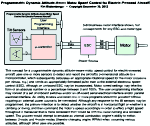 There is currently a big shift from internal
combustion engines to electric motors for powering model vehicles of all sorts -
airplanes, helicopters, boats, and cars - and of all control modes - autonomous
(free flight), radio control, and control-line. The state of motor and battery technology
has passed the point where the weight and thrust available with electric power meets
or exceeds that of engines for most applications. I'm throwing this idea out to
companies like Winged Shadow Systems, who make some ingenuous peripheral products
like the How High altimeter and the Thermal Scout thermal detector, and the Sky
Limit altitude/time limit motor cutoffs. Surely those guys can design and affordably
market a dynamic, attitude-aware motor control for electric-powered control line
airplanes. I provide here a basic outline of the concept, what I title "A
Programmable Dynamic Attitude-Aware Motor Speed Control for Electric-Powered Aircraft©."
While its indented initial application is for control line aircraft, it is possible
to extend the usage to free flight and other modes of flight... There is currently a big shift from internal
combustion engines to electric motors for powering model vehicles of all sorts -
airplanes, helicopters, boats, and cars - and of all control modes - autonomous
(free flight), radio control, and control-line. The state of motor and battery technology
has passed the point where the weight and thrust available with electric power meets
or exceeds that of engines for most applications. I'm throwing this idea out to
companies like Winged Shadow Systems, who make some ingenuous peripheral products
like the How High altimeter and the Thermal Scout thermal detector, and the Sky
Limit altitude/time limit motor cutoffs. Surely those guys can design and affordably
market a dynamic, attitude-aware motor control for electric-powered control line
airplanes. I provide here a basic outline of the concept, what I title "A
Programmable Dynamic Attitude-Aware Motor Speed Control for Electric-Powered Aircraft©."
While its indented initial application is for control line aircraft, it is possible
to extend the usage to free flight and other modes of flight...
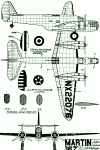 Plastic model kits were rare in 1939. For
that matter plastic "anything" was rare at the time. It was not until after World
War II that injection molded plastic was commonly found in commercial and household
items. Accordingly, the majority of small static display models were carved from
balsa, basswood, pine, or other soft woods with straight grain and no knots. Many
craftsmen honed their skills carving, sanding, painting, and detailing solid models
such as this
Martin
167 bomber which appeared in the December 1939 issue of Flying Aces
magazine. Boats, ships, cars, trains, trucks, and other types of vehicles and equipment
was commonly modeled, for both military and civilian varieties. In one of the vintage
modeling magazines - possibly Flying Aces - there was a photo of a guy
with his extensive model of a circus, including tents, beasts, human performers,
transport trucks and trailers. Different strokes for different folks, as the saying
goes... Plastic model kits were rare in 1939. For
that matter plastic "anything" was rare at the time. It was not until after World
War II that injection molded plastic was commonly found in commercial and household
items. Accordingly, the majority of small static display models were carved from
balsa, basswood, pine, or other soft woods with straight grain and no knots. Many
craftsmen honed their skills carving, sanding, painting, and detailing solid models
such as this
Martin
167 bomber which appeared in the December 1939 issue of Flying Aces
magazine. Boats, ships, cars, trains, trucks, and other types of vehicles and equipment
was commonly modeled, for both military and civilian varieties. In one of the vintage
modeling magazines - possibly Flying Aces - there was a photo of a guy
with his extensive model of a circus, including tents, beasts, human performers,
transport trucks and trailers. Different strokes for different folks, as the saying
goes...
 It's hard to believe 1961 was over half a
century ago (62 years to be more precise). That is when this "NARAM," the
National
Association of Rocketry Annual Meet, took place in Denver, Colorado. As with
the U.S. Navy's involvement in the Academy of Model Aeronautics (AMA) Nationals
(Nats), the U.S. Air Force, in July of 1961, officially encouraged model rocketry
as a hobby for USAF personnel, including the Civil Air Patrol (CAP, headquartered
at Ellington AFB, Texas, at the time). The USAF had a vested interest in encouraging
young men to develop an interest in rocket development, operation, and maintenance
in order to ensure an ample supply of enlisted and officer personnel for its missile
programs. The contest has held at the Hogback Rocket Range near Denver, which was
close to Lowry Air Force Base (now closed) and the U.S. Air Force Academy in Colorado
Springs... It's hard to believe 1961 was over half a
century ago (62 years to be more precise). That is when this "NARAM," the
National
Association of Rocketry Annual Meet, took place in Denver, Colorado. As with
the U.S. Navy's involvement in the Academy of Model Aeronautics (AMA) Nationals
(Nats), the U.S. Air Force, in July of 1961, officially encouraged model rocketry
as a hobby for USAF personnel, including the Civil Air Patrol (CAP, headquartered
at Ellington AFB, Texas, at the time). The USAF had a vested interest in encouraging
young men to develop an interest in rocket development, operation, and maintenance
in order to ensure an ample supply of enlisted and officer personnel for its missile
programs. The contest has held at the Hogback Rocket Range near Denver, which was
close to Lowry Air Force Base (now closed) and the U.S. Air Force Academy in Colorado
Springs...
 "NASA has announced a conceptual mission
architecture for the Mars Sample Return (MSR) program, and it's a pleasant surprise.
The goal of the proposed program is to return the rock samples that the Perseverance
rover is currently collecting on the Martian surface to Earth, which, as you can
imagine, is not a simple process. It'll involve sending a sample-return lander (SRL)
to Mars, getting those samples back to the lander, launching a rocket back to Mars
orbit from the lander, and finally capturing that rocket with an orbiter that'll
cart the samples back to Earth. As you might expect, the initial idea was to send
a dedicated rover to go grab the sample tubes from wherever Perseverance had cached
them and bring them back to the lander with the rocket, because how else are you
going to go get them, right? If Perseverance can’t make it, is to collect the samples
with two helicopters
instead..." "NASA has announced a conceptual mission
architecture for the Mars Sample Return (MSR) program, and it's a pleasant surprise.
The goal of the proposed program is to return the rock samples that the Perseverance
rover is currently collecting on the Martian surface to Earth, which, as you can
imagine, is not a simple process. It'll involve sending a sample-return lander (SRL)
to Mars, getting those samples back to the lander, launching a rocket back to Mars
orbit from the lander, and finally capturing that rocket with an orbiter that'll
cart the samples back to Earth. As you might expect, the initial idea was to send
a dedicated rover to go grab the sample tubes from wherever Perseverance had cached
them and bring them back to the lander with the rocket, because how else are you
going to go get them, right? If Perseverance can’t make it, is to collect the samples
with two helicopters
instead..."
 Here is another sailplane that, like the
Aquila, really appealed to me back when I first saw it in the August 1974 edition
of American Aircraft Modeler magazine. The
Astro−Jeff's 12'−7" (151")
wingspan and 1370 sq. in. of wing area, was too much for my 16-year-old wallet.
The cost to build and cover it, and then the launch system needed was way more than
what I was accustomed to paying compared to my Standard Hi-Start and 72" and 99"
gliders (the 2−meter class hadn't been created yet). I had forgotten about the Astro−Jeff
until a few years ago when I ran across a re-kitting of it by Mr. Jim Ealy of Vintage
Sailplaner. He offers a short and full kit of the Astro−Jeff with a fiberglass fuselage.
Maybe now that I have a lot more money (don't I wish), someday I probably will finally
build one of my own... Here is another sailplane that, like the
Aquila, really appealed to me back when I first saw it in the August 1974 edition
of American Aircraft Modeler magazine. The
Astro−Jeff's 12'−7" (151")
wingspan and 1370 sq. in. of wing area, was too much for my 16-year-old wallet.
The cost to build and cover it, and then the launch system needed was way more than
what I was accustomed to paying compared to my Standard Hi-Start and 72" and 99"
gliders (the 2−meter class hadn't been created yet). I had forgotten about the Astro−Jeff
until a few years ago when I ran across a re-kitting of it by Mr. Jim Ealy of Vintage
Sailplaner. He offers a short and full kit of the Astro−Jeff with a fiberglass fuselage.
Maybe now that I have a lot more money (don't I wish), someday I probably will finally
build one of my own...
 Although this solicitation for membership
to the
Flying Aces Club appeared in a 1939 issue of Flying Aces magazine,
it might as aptly show up in the next edition of the AMA Model Aviation
magazine, for the Flying Aces Club is still in existence lo these 83 years hence.
The wording would be a little different - especially the list of Honorary Member
names almost none of which today many people would recognize - but the theme hasn't
changed. I took the time to look up and hyperlink to biographies of everyone in
the list. Having been born in 1950 and being a life-long aviation aficionado, I
am familiar with probably half the people. You will see a lot of aircraft designer
names in there. One notable absence is Charles A. Lindberg, which makes me wonder
if the "Honorary" title is bestowed upon certain people whether or not they are
aware of it and accept the honor. In fact, I'm pretty sue Mr. Lindberg was an active
model builder and flyer, and was a regular member of the Flying Aces Club... Although this solicitation for membership
to the
Flying Aces Club appeared in a 1939 issue of Flying Aces magazine,
it might as aptly show up in the next edition of the AMA Model Aviation
magazine, for the Flying Aces Club is still in existence lo these 83 years hence.
The wording would be a little different - especially the list of Honorary Member
names almost none of which today many people would recognize - but the theme hasn't
changed. I took the time to look up and hyperlink to biographies of everyone in
the list. Having been born in 1950 and being a life-long aviation aficionado, I
am familiar with probably half the people. You will see a lot of aircraft designer
names in there. One notable absence is Charles A. Lindberg, which makes me wonder
if the "Honorary" title is bestowed upon certain people whether or not they are
aware of it and accept the honor. In fact, I'm pretty sue Mr. Lindberg was an active
model builder and flyer, and was a regular member of the Flying Aces Club...
 Early
"servos"
were nothing more than the electromechanical equivalents of rubber band-powered
escapement. Rather than energizing a solenoid that would allow the rubber band to
turn the control arm, the pulse signal from the receiver would set a motor in motion,
and then limit switches would stop it once the predetermined position was reached.
They had a number of advantages over rubber-powered escapements in that the power
delivered to the control surface was not diminished with every actuation (except
from some negligible energy drain from the batteries), they were able to deliver
a lot more power, and they took up less real estate inside the fuselage. It was
a first step toward today's proportional servos. This 1955 issue of Popular
Electronics magazines shows the state of the art in the day... Early
"servos"
were nothing more than the electromechanical equivalents of rubber band-powered
escapement. Rather than energizing a solenoid that would allow the rubber band to
turn the control arm, the pulse signal from the receiver would set a motor in motion,
and then limit switches would stop it once the predetermined position was reached.
They had a number of advantages over rubber-powered escapements in that the power
delivered to the control surface was not diminished with every actuation (except
from some negligible energy drain from the batteries), they were able to deliver
a lot more power, and they took up less real estate inside the fuselage. It was
a first step toward today's proportional servos. This 1955 issue of Popular
Electronics magazines shows the state of the art in the day...
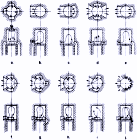 Even while electric propulsion systems are
gaining ground in the modeling realm,
2- and 4-cylinder
engines are still quite popular amongst modelers. I have made a switchover totally
to electric, but I sure miss the sound and smell of the nitro engines. For those
who still use internal combustion engines, and for those who just want to learn
a little more about how these model engines work, this article by Glenn Lee in the
February 1968 issue of American Aircraft Modeler magazine will be a very
useful read... Even while electric propulsion systems are
gaining ground in the modeling realm,
2- and 4-cylinder
engines are still quite popular amongst modelers. I have made a switchover totally
to electric, but I sure miss the sound and smell of the nitro engines. For those
who still use internal combustion engines, and for those who just want to learn
a little more about how these model engines work, this article by Glenn Lee in the
February 1968 issue of American Aircraft Modeler magazine will be a very
useful read...
 Crash Carringer was one of Arch Whitehouse's
later ace pilot characters. Officially an aircraft salesman for Hale Aircraft Corporation
on Long Island, New York. However, in his efforts to prove the superiority of his
prized Hellion monoplane fighter with a twin tail boom configuration, he often ended
up fighting and winning dogfights against evil worldwide crime organizations who
were often in league with governments of notorious for desiring to rule the Earth.
World War I had been over for nearly two decades and World War II was
newly on the table following Hitler's and Hirohito's invasions in Europe and Asia,
respectively. Accordingly, those two countries played prominently in the stories.
As with most of these sorts of stories in Flying Aces magazine, they were quite
long, filling eight to ten full pages... Crash Carringer was one of Arch Whitehouse's
later ace pilot characters. Officially an aircraft salesman for Hale Aircraft Corporation
on Long Island, New York. However, in his efforts to prove the superiority of his
prized Hellion monoplane fighter with a twin tail boom configuration, he often ended
up fighting and winning dogfights against evil worldwide crime organizations who
were often in league with governments of notorious for desiring to rule the Earth.
World War I had been over for nearly two decades and World War II was
newly on the table following Hitler's and Hirohito's invasions in Europe and Asia,
respectively. Accordingly, those two countries played prominently in the stories.
As with most of these sorts of stories in Flying Aces magazine, they were quite
long, filling eight to ten full pages...
 "The solar-powered
Zephyr drone beat its own record for time spent aloft as an uncrewed aircraft
system, with 36 days completed so far, and counting, according to Army Futures Command.
AFC's Assured Positioning, Navigation and Timing/Space Cross-Functional Team launched
the aircraft on June 15 and it remains deployed some 70,000 feet over Arizona. The
pilotless aircraft previously set the longevity record at about 26 days in 2018.
The first stratospheric UAS of its kind, Zephyr can fly continuously for months
at a time, far above weather and conventional air traffic. It has a wingspan of
just over 82 feet - longer than 2 school buses placed end-to-end, but weighs less
than 166 pounds." "The solar-powered
Zephyr drone beat its own record for time spent aloft as an uncrewed aircraft
system, with 36 days completed so far, and counting, according to Army Futures Command.
AFC's Assured Positioning, Navigation and Timing/Space Cross-Functional Team launched
the aircraft on June 15 and it remains deployed some 70,000 feet over Arizona. The
pilotless aircraft previously set the longevity record at about 26 days in 2018.
The first stratospheric UAS of its kind, Zephyr can fly continuously for months
at a time, far above weather and conventional air traffic. It has a wingspan of
just over 82 feet - longer than 2 school buses placed end-to-end, but weighs less
than 166 pounds."
|



